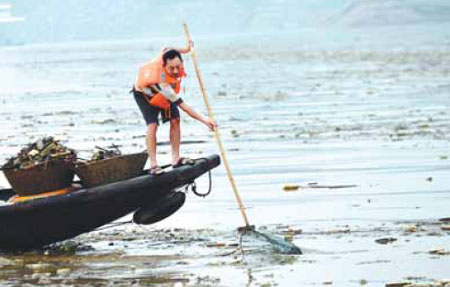Sewage data platform to keep Yangtze basin clean

Authorities plan online monitoring of discharge after on-site checks
Data from all major sewage discharge points in the Yangtze River basin are to be shared among environmental authorities using an online monitoring platform to boost pollution controls.

The move comes after the Yangtze River Water Resources Commission and Taihu Lake Basin Authority completed on-site inspections last year at more than 8,800 locations in 887 counties.
Authorities have drawn up a list of 6,092 major sewage points with a daily discharge of 300 metric tons or an annual discharge of 100,000 tons.
Those not already fitted with the required monitoring equipment will be upgraded, and an online platform will be set up to share the information collected with environmental protection departments covering the region, according to a statement from the commission.
Water quality readings from rivers in the Yangtze River basin have continued to improve in recent years. In 2016, 39,972 kilometers of river - 56.7 percent of all sections monitored - were found to be Grade I or II, the top categories in the national standard for surface water. In 2014, it was only 52 percent.
Over the same period, the number of sections worse than Grade V, the lowest standard, fell from 9.7 to 4.9 percent.
This is despite an increase in sewage discharge in that time from about 33.9 billion tons to 35.3 billion tons, according to the commission, which said the figures exclude cooling water from thermal power plants, mine drainages and sewage discharge in the Tibet autonomous region.
"The discharge increased mainly because of the rise in water consumption for economic development in the basin. The water treated by sewage treatment plants is also included in the calculation," said Jin Xingping, the commission's chief engineer.
"We're not afraid of the increase of sewage discharge, as it can't be avoided as the economy develops. What we will tightly control are the hazardous substances in the sewage."
Despite improvements in water quality, the two authorities said they found many problems during the monthlong on-site inspections.
Some discharge points were set too close to the water intakes of water supply plants, while "some local authorities are short-staffed in terms of sewage discharge monitoring or lack the required online monitoring equipment", the commission said.
The authority added that it has demanded billboards carrying a phone number or WeChat account be placed near all sewage discharge points to help people report any problems.
Wang Fangqing, head of water resources protection for the commission, said the Yangtze River commission and the Taihu authority will continue to promote reforms in sewage discharge practices.
Twenty-four points were shut down last month and more will follow in June, he said. "With these measures, we will further regulate sewage discharge systems along the basin to improve water quality," he added.
Contact the writers at houliqiang@chinadaily.com.cn
- Jilin winter fishing festival fetches record auction, visitors
- China pushes higher education reform with focus on tech and industry
- Emergency crews battle wildfire in Shenzhen
- China CDC urges precaution amid surge in rhinovirus cases
- Govt to streamline health insurance payments over next 3 years
- China urges global vigilance against revival of Japanese militarism





































